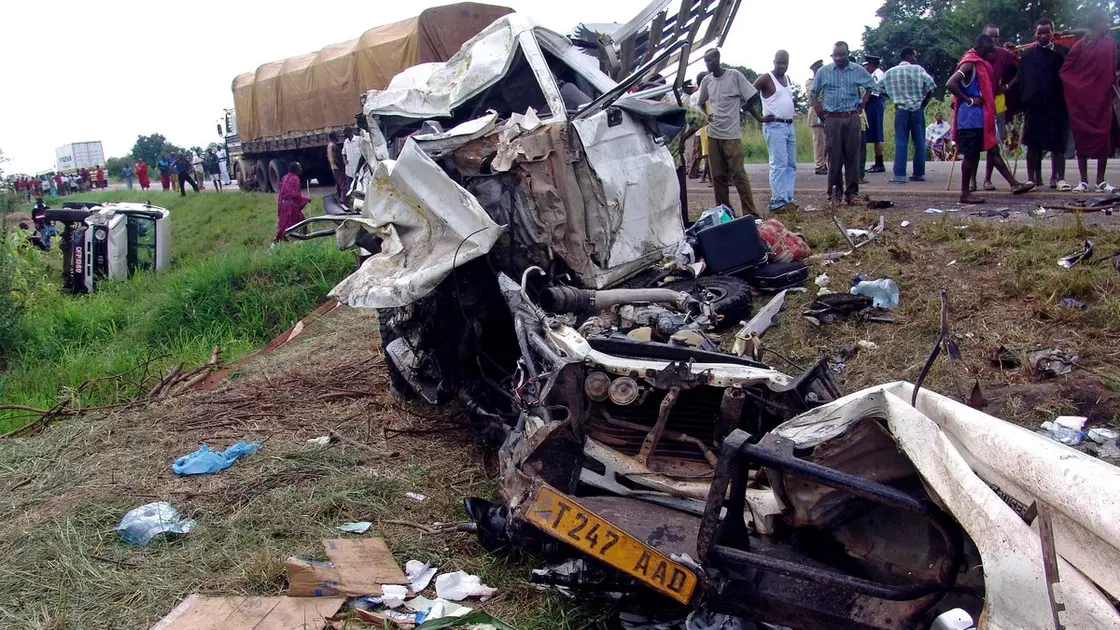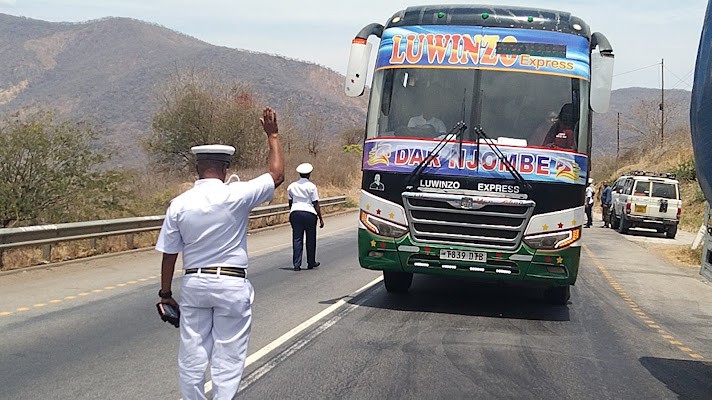In a truly remarkable manner, let me take this opportunity to commend the Tanzanian Traffic Police Force for their tremendous efforts in ensuring that safety flourishes on our roads, particularly for drivers operating motor vehicles in our country.
Statistical data on Road Accidents in Tanzania
A staggering total of 886 Tanzanians lost their lives between January and November 2022 due to road accidents, including young individuals, while another 573 were left with injuries in the recorded 1,422 accidents by the Traffic Police Unit of the Police Force. These accidents escalated from the 1,177 recorded between January and August 2022. This implies that within a span of three months, 245 new accidents occurred.

Remarkably, the Tanzanian Traffic Police Force has risen to the occasion, actively engaging in initiatives and implementing stringent measures to combat this pressing issue. With their unwavering dedication and tireless efforts, they are steadfastly working towards transforming our roads into secure and protected spaces.
The statistics may seem disheartening, but they serve as a poignant reminder of the crucial importance of promoting road safety and adhering to traffic regulations. Together, we can forge a brighter future where the roads become havens of serenity and security, allowing us to embark on our journeys with peace of mind.
According to a report presented to the 12th Parliament in February 2023 by the Committee on Foreign Affairs, Defense, and Security, a staggering 382 individuals have been reported to have lost their lives from October to December 2022. This represents a 4.1% increase compared to the 367 fatalities recorded during the same period in 2021.
The primary cause of this alarming rise has been attributed to road accidents that occurred across various regions of the country during that time.
Road Chronicles experience: Beyond Road safety Operations in Tanzania
Allow me to draw upon a vivid memory from my time as an independent journalist in Iringa. Reporting for the renowned news outlet, Supreme Digital Media. In 2022, I received an invitation to join the police force in Iringa Region as a Journalist to cover the story. Led by the esteemed Regional Police Commander, RPC Alan Bukumbi, and the Chief of the Regional Traffic Police Unit, RTO Mosi Ndozero, this operation was aimed at addressing the issue of drivers who blatantly disregard road safety regulations.

This unique opportunity gave me firsthand insight into the tireless efforts and commitment of the law enforcement authorities in combatting this growing menace on our roads. The joint operation served as a testament to their dedication to ensuring the safety and well-being of all road users. The synchronized efforts of the police and the traffic unit were a remarkable display of their determination to bring order and accountability to our roadways.
Witnessing this operation firsthand, I couldn’t help but feel a surge of hope and admiration for the unwavering commitment of those who strive to protect and preserve human life. It was a powerful reminder that we, as a society, must join hands and work collectively to address the pressing issue of road safety.
Indeed! I commend the police force for their tremendous work! It was a massive and powerful operation aimed at ensuring road safety against Road accidents is upheld to the highest standards. Education was provided to the drivers, and, unfortunately, those who broke the law ended up in the hands of these commanders. It’s both saddening and disheartening!
The Untold Story: A Dive into the Genesis of This Enthralling Article
Now, as I was scrolling through social media, I came across a tweet that featured a video showing a traffic officer pulling over a long-haul driver for alleged traffic violations. Suddenly, the officer abruptly stopped the vehicle in the middle of the road, endangering the safety of other drivers. A heated argument ensued between the two, escalating into a physical altercation. I was genuinely shocked!
Truthfully, the use of our handheld phones and globalization is leading us astray! We have started reporting online instead of reporting to the relevant authorities first. It made me believe that every devil has its own baobab tree! We are prioritizing the realm of social media and failing to solve real-life issues promptly!
Katika hali hili nani alaumiwe????
Video chini ???? pic.twitter.com/WkcN1lJqZI
— Moker???? (@mokertz__) July 18, 2023
It left me with questions swirling in my mind. How did common sense fail to prevail between the traffic officer and the driver? Did the traffic officer create an environment for corruption in that situation? Did the driver fail to cooperate with the officers, refusing to acknowledge their wrongdoing, or was it a lack of knowledge about the law? Numerous questions lingered in my thoughts!
Some individuals on Twitter speculated that perhaps there was a failure of self-awareness or that the issue lay with the traffic officers’ failure to understand their responsibilities or adhere to traffic laws. How can we explain such behavior?
These incidents highlight a deeper concern that goes beyond a single confrontation. They point to the need for comprehensive training, effective communication, and a shared understanding of the importance of road safety among all stakeholders. Both drivers and law enforcement officials have a vital role to play in creating a culture of responsibility, respect, and compliance with traffic regulations.
This made me delve- deeper into how traffic laws address these issues:
The Foundation of the Road Traffic Act of 1973
The existence of this Road Traffic Act is rooted in the technological advancements and transportation systems that humans have created to streamline their activities. In urban areas, there are various modes of transportation, whether it be in the air, on water, or on land. However, the predominant use of transportation occurs on land, specifically on roads. Governments have invested heavily in infrastructure development to ensure easy accessibility throughout the country.
This development has led to the significant challenge of increased road traffic and a greater number of road users and sometimes road accidents. The surge in vehicles and users has brought about the problem of road accidents and misuse, resulting in substantial losses for the nation by depleting its workforce.
What does the road traffic act of 1973 say about speed?
Section 51 states, among other things:
- In residential areas, the speed limit should not exceed 50 kilometers per hour.
- In non-residential areas, speed limits will be controlled by road signs.
- Vehicles exceeding 3500 tons should not exceed 80 kilometers per hour.
Offenses Specified by the Law
This law delineates numerous offenses that can occur on the road. The enforcement of this law is the responsibility of a specialized unit within the Police Force known as the Traffic Police. This unit is tasked with coordinating and overseeing the implementation of the Road Traffic Act.
Some offenses specified in the Road Traffic Act include:
- Driving a vehicle or motorized device without proper authorization from the relevant authority.
- Failure to carry the vehicle registration document while operating a motorized vehicle.
- Using a motorized vehicle for instructional purposes without proper registration and recognition as a training vehicle (displaying a ‘Learner’ sign).
- Failing to stop at a railway crossing.
- Driving excessively slowly without any justifiable reason, and so on.
According to the Road Traffic Act, drivers have several responsibilities to adhere to road safety. These responsibilities include:
- Obeying Traffic Laws: Drivers are required to follow all traffic laws and regulations. This includes obeying speed limits, traffic signals, road signs, and lane markings. Drivers must also adhere to rules regarding overtaking, signaling, stopping at intersections, and yielding right of way to avoid road accidents.
- Driving with Due Care and Attention: Drivers have a duty to drive with due care and attention to ensure the safety of themselves, their passengers, and other road users. This means being alert, attentive, and focused on the task of driving, avoiding distractions such as mobile phones, and adjusting driving behavior to prevailing road conditions.
- Maintaining Vehicle Roadworthiness: Drivers are responsible for ensuring that their vehicles are in a safe and roadworthy condition. This includes regularly maintaining and servicing the vehicle, checking the tires, brakes, lights, and other essential components to ensure proper functionality. Neglecting vehicle maintenance can compromise road safety.
- Carrying Valid Documentation: Drivers must possess and carry valid documentation while operating a vehicle. This includes a valid driver’s license that corresponds to the class of vehicle being driven. Additionally, drivers must carry vehicle registration documents, proof of insurance, and any other required permits or licenses.
- Exercising Courtesy and Respect: Drivers should demonstrate courtesy, respect, and consideration towards other road users. This includes giving way when appropriate, using turn signals to indicate intentions, refraining from aggressive or reckless driving behaviors, and maintaining patience in congested or challenging traffic situations.
- Reporting Accidents and Providing Assistance: In the event of an accident, drivers have a responsibility to stop at the scene, provide necessary assistance to injured parties (if possible and safe to do so), and report the accident to the appropriate authorities as required by law.
The Tanzania Road Traffic Act comprehensively addresses the violation of rules and outlines the responsibilities of traffic participants. Here are some key points from the Act:
- Traffic Rules: The Act establishes a set of traffic rules that must be adhered to by all road users. These rules cover various aspects, including speed limits, signaling and overtaking, parking, and general conduct on the road.
- Offenses and Penalties: The Act defines a wide range of traffic offenses, such as speeding, drunk driving, reckless driving, driving without a valid license, disobeying traffic signals, and overloading vehicles. Each offense is associated with specific penalties, which may include fines, imprisonment, or both, depending on the severity of the violation.
- Responsibilities of Drivers: The Act places several responsibilities on drivers. These include obeying traffic rules, driving with due care and attention, ensuring the vehicle is roadworthy, carrying proper documentation (such as a valid driver’s license and vehicle registration), and providing assistance in the event of an accident.
- Responsibilities of Vehicle Owners: The Act also imposes responsibilities on vehicle owners. They are required to register their vehicles, obtain valid insurance, and ensure that the vehicle is in a safe and roadworthy condition. Owners may be held liable for offenses committed by others using their vehicles if they can be proven negligent in entrusting their vehicle to an unfit or unauthorized driver.
- Traffic Control and Enforcement: The Act grants powers to traffic police officers and other authorized officials to enforce traffic laws, control traffic flow, and issue fines or citations for violations. It also allows for the use of technology, such as speed cameras and breathalyzers, to assist in enforcement efforts.
- Traffic Education and Awareness: The Act emphasizes the importance of traffic education and awareness programs to promote responsible behavior on the road. It encourages public education initiatives and cooperation between government bodies, non-governmental organizations, and educational institutions to raise awareness about road safety.
What is the destiny of solving challenges like this?
In this, we should not search for a witch to blame, nor seek the root of the turmoil elsewhere. Absolutely not! By obeying traffic laws, driving with care and attention, maintaining their vehicles properly, carrying valid documentation, and exercising courtesy and respect, drivers contribute to creating a safer road environment for everyone.
The Road Traffic Act provides the framework for enforcing these responsibilities and addressing violations. It is imperative that drivers understand and adhere to these regulations to mitigate the risks of accidents and protect lives. Let us all embrace our role in promoting road safety against Road accidents in Tanzania and work together towards a future where our roads become havens of security and tranquility for all.
Read more insightful analysis here.


[…] Also, Read how a Tanzania Traffic Police Department implements a Battle against Road accidents in Tanzania. […]